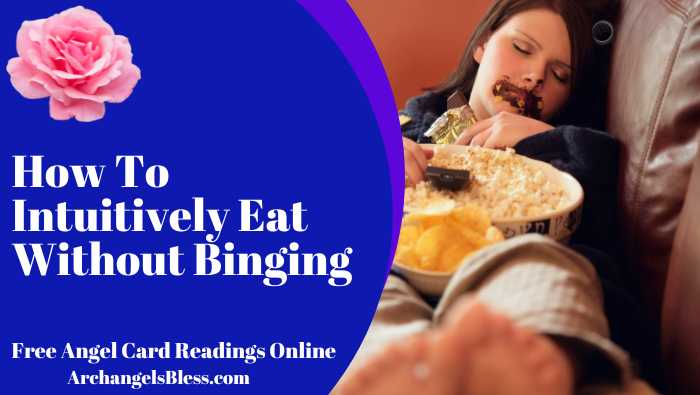How To Intuitively Eat Without Binging
If you’re someone who struggles with binge eating, you know how difficult it can be to control your food intake.
You may feel like you’re always thinking about food and what you should or shouldn’t be eating.
It can be hard to break the cycle of bingeing, but it is possible. Here are some tips on how to intuitively eat without binging:
1. Check in with yourself before reaching for food. Ask yourself why you’re hungry and what you’re craving. If you’re not actually physically hungry, chances are you’re just looking for something to satisfy an emotional need.
2. Slow down when you eat. savor each bite and pay attention to how your body feels as you eat. This will help you become more aware of when you’re actually full.
3. Don’t eat in front of the TV or computer screen. It’s too easy to mindlessly munch on junk food while you watch TV, and it can be hard to determine how much you’ve eaten when you’re distracted.
4. Eat slowly. Chew each bite well and allow yourself 30 to 60 minutes to finish a meal.
Intuitive Eating Principles
There are 10 basic principles of Intuitive Eating, a non-diet approach to health and wellness that was created by two dietitians in the early 1990s.
These principles can help you break your diet mentality, make peace with food, and nurture a healthy relationship with your body.
The first principle is to honor your hunger. This means listening to your body’s cues and eating when you’re actually hungry, not just when it’s time to eat or when you’re bored.
The second principle is to make peace with food. This means giving yourself permission to eat all foods, without restriction or judgement.
The third principle is to respect your fullness. This means stopping eating when you’re no longer hungry, even if there’s food left on your plate.
The fourth principle is to discover the satisfaction factor. This means finding the balance between eating for nutrition, for pleasure, and for weight management.
The fifth principle is to nurture your inner self. This means embracing the fact that food cannot nourish your soul like love can.
The sixth principle is to trust in your body’s wisdom. This means learning to listen to your body to find pleasure and satisfaction through food.
The seventh principle is to practice mindful eating. This means focusing on your food and eating in a slow, relaxed manner.
The eighth principle is to eat with awareness. This means being aware of everything that you put in your mouth.
The ninth principle is to practice moderation. This means eating a little bit of everything and stopping when you’re full.
The tenth principle is to enjoy your food. This means eating with joy and pleasure!
Intuitive Eating Benefits
A new way of thinking about food is on the rise, and it’s called intuitive eating.
This approach to nourishment goes beyond the traditional ideas of dieting and instead focuses on listening to your body’s natural hunger cues.
Intuitive eating has been shown to have a number of benefits, both physically and mentally.
For starters, ditching the restrictive diet mentality can lead to a healthier relationship with food.
When you allow yourself to eat what you want, when you want it, you’re less likely to fall into the dangerous cycle of bingeing and restricting.
This can lead to improved body image and self-esteem, as well as increased satisfaction with meals.
Intuitive eating has also been linked with better physical health outcomes.
How To Start Intuitively Eating
If you’re interested in intuitive eating but don’t know where to start, this article is for you! Here are three tips to get you started on your journey to intuitive eating.
1. Start by learning about the basics of intuitive eating. What is it? How does it work? What are the benefits? There are tons of resources available online and in libraries.
2. Pay attention to your hunger cues. When do you feel most hungry? What types of foods sound good to you in that moment? This will help you start to listen to your body’s needs.
3. Don’t be too hard on yourself. Intuitive eating is a process and it takes time to learn how to do it. If you have a slip-up, don’t beat yourself up about it. Just get back on track and keep going!
Intuitive Eating Plan
If you’re struggling with your weight, you may be feeling frustrated and helpless.
But there is hope!
The intuitive eating plan can help you get back on track and start making healthier choices.
This approach to nutrition is based on the idea that you should eat when you’re hungry and stop when you’re full.
It’s a more natural way of eating that can help you break the cycle of yo-yo dieting.
The intuitive eating plan is not a diet, but it can help you make healthier choices.
By listening to your body’s signals, you can learn to eat what you need and enjoy your food more.
How To Lose Weight With Intuitive Eating
Losing weight with intuitive eating may sound counterintuitive, but it can be an effective way to reach your goals.
Intuitive eating is all about listening to your body and giving it what it needs.
This means being mindful of your hunger cues and eating when you’re truly hungry, not just when you’re bored or emotional.
It also means choosing foods that make you feel good both physically and emotionally.
If you’re ready to give intuitive eating a try, here are a few tips to get started:
1. Pay attention to your hunger cues. When you’re truly hungry, your stomach will usually feel empty or uncomfortable. Pay attention to these cues and start eating when you first feel hungry.
2. Don’t deprive yourself. If you’re craving a specific food, it’s OK to indulge occasionally. Just make sure that you choose something that truly satisfies you.
3. Eat enough to feel satisfied, but not stuffed. Eating until you’re full can prevent weight loss and cause bloating.
4. Don’t eat when you’re emotional or bored.
If you eat when you’re sad or upset, you might end up eating more than you need and feel guilty about it later.
5. Go for healthy snacks between meals if you get hungry. Keep healthy snacks, such as fruits and vegetables or low-calorie dip, in your work area to help you avoid the vending machine.
6. Don’t eat late at night. Eating late may mean that you’re eating more calories than you need to.
What Is Wrong With Intuitive Eating
There is a lot of debate about what intuitive eating is and whether or not it’s a good way to eat.
Some people say that it’s a way to listen to your body and eat what you want when you want.
Others say that it’s just another fad diet.
So, what is wrong with intuitive eating?
One problem is that it can be hard to know when you’re actually hungry.
If you’re used to eating when you’re not really hungry, it can be hard to break that habit.
Another problem is that some people use intuitive eating as an excuse to overeat.
They might think, “I’m just following my intuition, so I must be really hungry!”
And then they eat more than they need.
How To Practice Intuitive Eating
If you’re sick of feeling guilty after finishing a bag of chips or a pint of ice cream, it might be time to consider intuitive eating.
Intuitive eating is all about listening to your body’s hunger cues and giving yourself permission to eat what you really want.
Here are some tips for practicing intuitive eating:
1. Pay attention to your hunger cues. Before you eat, ask yourself if you’re actually hungry. If you are, proceed to step 2. If you’re not, try drinking a glass of water or waiting a few minutes to see if the feeling passes.
2. Make sure you’re eating what YOU want. This may seem like a no-brainer, but so often we eat things because they’re “healthy” or because someone else is eating them.
3. Stop when you’re satisfied, not full. If you’re eating a healthy meal, chances are you won’t feel stuffed and uncomfortable.
4. Don’t eat because you’re bored, sad or stressed. If you’re not hungry, don’t eat.
How To Learn To Eat Intuitively
Are you someone who is always on a diet, only to find yourself back at square one a few weeks later?
If so, you are not alone.
According to research, 95% of diets fail.
So, what’s the alternative?
Learning to eat intuitively.
What is intuitive eating?
It is “a self-care eating framework which integrates instinct, emotion, and cognition to support long-term health and well-being.”
In other words, it is listening to your body and giving it what it needs.
Here are a few tips to help you get started:
1. Ditch the diet mentality. Diets don’t work in the long run and they can actually do more harm than good. If you want to make a change that will last, focus on changing your relationship with food.
2. Get comfortable with food. Learn to be mindful of your eating habits, and give yourself permission to eat what you want, when you want it.
3. Stop counting calories. You can t trust your body if you are constantly lying to it by deceiving it with numbers on a scale.
How To Intuitively Eat Without Binging Conclusion
In conclusion, intuitive eating is a process of getting in touch with your inner hunger cues and learning to eat in response to those cues.
It is a process that can help you break the cycle of yo-yo dieting and binging, and it can lead to a healthier relationship with food.
If you’re interested in trying intuitive eating, start by paying attention to your body’s hunger signals and eating in response to those signals.
You may also enjoy…
Receive FREE Angel Card Readings [Anytime Day or Night]
How To Attract Good Luck [With The Angels Help]
May you remember how Divine you truly are!
In Love & Grace,




0 Comments